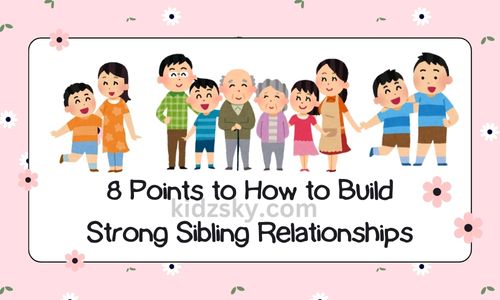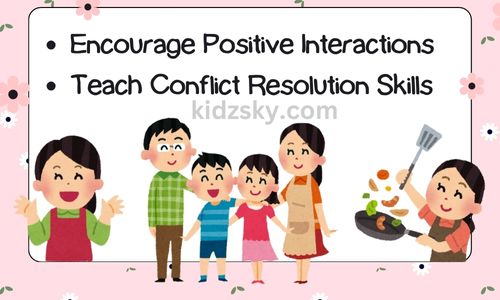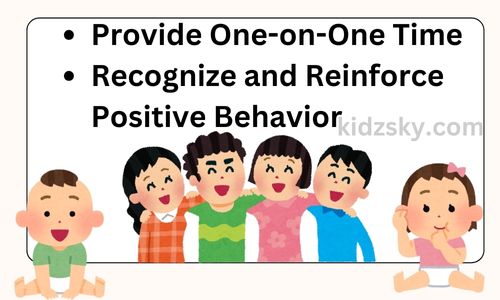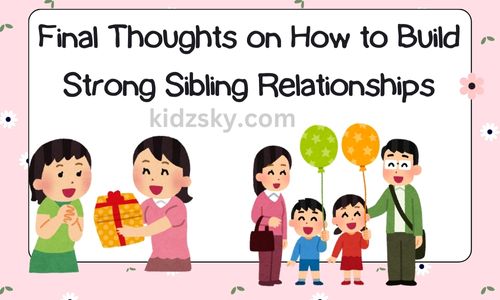Sibling relationships are some of a child’s longest-lasting and most important connectionsHow to Build Strong Sibling Relationships? A strong sibling bond fosters love, support, and trust between brothers and sisters
As parents, you play a crucial role in helping your children develop positive and lasting relationships with one anotherSo, this blog will be our special one
Here, we’ll walk you through simple steps and tips on how to build strong sibling relationships and the benefits of nurturing sibling harmony.

8 Points to How to Build Strong Sibling Relationships
Before we dive into the steps on How to Build Strong Sibling Relationships, it’s essential to understand why sibling bonds are so importantA strong relationship between siblings can:
- Provide emotional support during one’s challenging times.
- Encourage cooperation and teamwork.
- Teach children about conflict resolution and compromise.
- Foster lifelong friendships.
- Help develop empathy and understanding.
With that foundation in mind, let’s explore how parents can help build and maintain strong sibling relationships.
Step 1: Encourage Positive Interactions
One of the first steps in How to Build Strong Sibling Relationships is encouraging positive interactions between your childrenThis includes promoting activities that require teamwork, such as playing games, building projects, or solving puzzles together.
Parents can:
- Create shared experiences by planning family outings or projects that require collaboration.
- Encourage your kids to help each other with homework or daily tasks.
- Celebrate their teamwork by praising how well they worked together.
By providing opportunities for positive experiences, you help your kids bond over shared accomplishments and develop trust in one another.
Recently Published:- Benefits of Outdoor Activities for Kids: 6 Complete Guide

Step 2: Teach Conflict Resolution Skills
Sibling conflicts are natural, but how these disputes are handled can strengthen or weaken the bond between siblingsTeaching your children how to resolve conflicts in a healthy way is a critical part of How to Build Strong Sibling Relationships.
Here’s how there’s help:
- Teach them to express their feelings without yelling or name-calling.
- Help them listen to each other’s persother’ss.
- Guide them to come up with compromises that both can agree on.
By teaching conflict resolution skills, you empower your children to handle disagreements maturely and with respect for each other’s feelings
Step 3: Celebrate Differences.
Another essential aspect of How to Build Strong Sibling Relationships is celebrating the individuality of each childEvery sibling has unique interests, talents, and personality traitsEncouraging your kids to appreciate these differences will help them respect each other’s spacother’sndividuality.
What you can do:
- Avoid comparing siblingsInstead, highlight their strengths and uniqueness.
- Encourage your children to support each other’s interests, even if they differ.
- Create an environment where differences are celebrated, not criticized.
This not only prevents jealousy but also nurtures admiration and respect among siblings.
Read Kids Favorite:- Fun Indoor Activities for Kids: 5 Perfect during Rainy Days

Step 4: Create Special Family Traditions
Family traditions play a significant role in How to Build Strong Sibling RelationshipsCreating memorable moments that involve all siblings can strengthen their connection over time.
Ideas to try:
- Start a weekly family game night.
- Plan annual family vacations where siblings can bond in a fun and relaxed environment.
- Create holiday traditions that everyone can look forward to together.
Shared traditions give your children something to cherish and anticipate, strengthening their emotional ties and collective memories.
Step 5: Be a Good Role Model
Children learn by example, so it’s essential to model the behavior you want to see in your kidsIn the context of How to Build Strong Sibling Relationships, showing kindness, respect, and patience in your interactions with family members can make a significant impact.
How to be a positive role model:
- Treat all family members with respect, even during disagreements.
- Demonstrate empathy by listening to your children’s children and validating them.
- Show your kids how to support and celebrate one another.
Setting a positive example teaches children how to foster healthy and loving relationships.
Special Blog:- How to Prepare Kids for Their First Day of School: 7 Excited

Step 6: Encourage Shared Responsibility
Giving your children shared responsibilities is a great way to teach cooperation and teamwork, two critical factors in How to Build Strong Sibling Relationships.
What you can do:
- Assign chores that require teamwork, like tidying up their room or preparing a simple meal together.
- Create opportunities for older siblings to mentor younger ones, such as helping with schoolwork or guiding them in activities.
- Praise them for completing tasks together, reinforcing the value of collaboration.
Shared responsibilities teach your children that working together can lead to success and help build a sense of camaraderie.
Step 7: Provide One-on-One Time
Promoting sibling bonding is important; providing each child with individual attention is equally essentialDoing so can help avoid rivalry or jealousy and promote a healthier sibling dynamic.
Why one-on-one time matters:
- It reassures each child that they are valued individually.
- It reduces the need for siblings to compete for your attention.
- It strengthens your relationship with each child, making them feel secure and loved.
Balancing sibling time with one-on-one moments helps foster individual self-confidence while maintaining a solid sibling connection.
Must Read Blog:- Encourage Your Child to Do the Right Things: 8 Facts to Know

Step 8: Recognize and Reinforce Positive Behavior
When your children interact in a loving or supportive way, acknowledge and reinforce their positive behaviorPositive reinforcement is a critical strategy in How to Build Strong Sibling Relationships.
How to recognize positive behavior:
- Verbally praise your children when they help, support, or show kindness to each other.
- Reward their teamwork by offering fun activities, like a family outing or a movie night.
- Encourage them to express gratitude to one another, reinforcing positive feelings.
This type of positive reinforcement encourages children to continue their good behavior, making them more likely to cooperate and support one another.
Read Also:- Benefits of Perfect Toys for Kids: 6 Types, Choose the Best

Final Thoughts on How to Build Strong Sibling Relationships
Building strong sibling relationships takes time, patience, and consistent effortAs parents, you play a pivotal role in fostering a healthy, loving bond between your children that can last a lifetime
You can help your children develop a strong foundation of love, trust, and mutual respect by encouraging positive interactions, teaching conflict resolution, celebrating individuality, and modeling supportive behavior
Follow these simple steps, and you’ll be on your way to How to Build Strong Sibling Relationships that will benefit your children for years.
Focusing on these practical strategies can create a home environment where sibling bonds flourish and growRemember, strong sibling relationships enrich your children’s children and provide them with a lifelong support system.
We request that you share this blog and spread the knowledge.
Admin creates all Photos used in this blog in Canva.




[…] Our Latest Blog:- How to Build Strong Sibling Relationships: 8 Points with e.g[…]
[…] Our Latest Blog:- How to Build Strong Sibling Relationships: 8 Points with e.g[…]
[…] Our Latest Blog:- How to Build Strong Sibling Relationships: 8 Points with e.g[…]